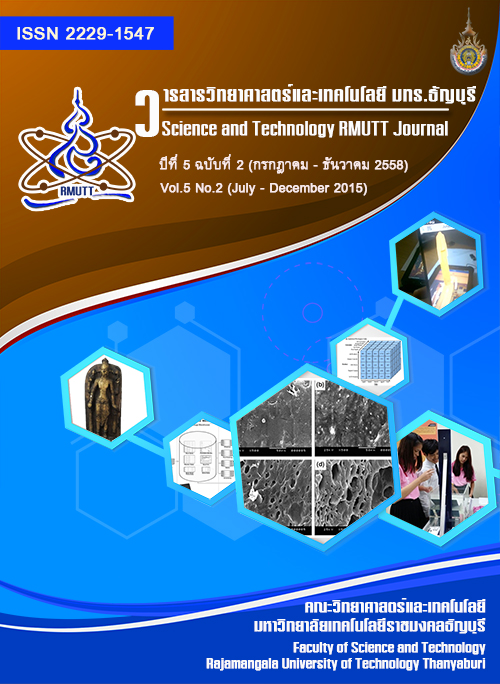Phytoplanktons and Water Quality in Nong Yasai and Nong Hai Reservoirs, Sakon Nakhon Rajabhat University, Sakon Nakhon Province
Main Article Content
Abstract
Nong Yasai and Nong Hai are the important water supplied reservoirs for human consumption in Sakon Nakhon Rajabhat University and surrounding areas. The blooming of Euglena sp. and polluted water quality were reported in Nong Yasai Reservoir in June 2013. In this research study, the diversity of phytoplanktons as well as the water quality of Nong Yasai and Nong Hai Reservoirs located in Sakon Nakhon Rajabhat University were investigated between June 2014 - May 2015. Seven divisions comprised of 35 genera of 56 species of phytoplanktons in Nong Yasai reservoir were found and the dominant species were identified as Cylindrospermopsis raciborskii (Woloszyńska) Seenayya & Subba Raju, Scenedesmus sp.1 and Planktolyngbya contorta (Lemmermann) Anagnostidis & Komárek. An examination of the diversity of phytoplanktons in Nong Hai Reservoir found 6 divisions of 27 genera and 37 species with the dominant species being Monoraphidium contortum (Thuret) Komárková-Legnerová, Dinobryon divergens O.E. Imhof and Staurastrum tetracerum Ralfs ex Ralfs. An assessment of the water quality using AARL-PC Score found it to be classified in the mesotrophic status (moderate water quality) in the Nong Yasai Reservoir and oligotrophic-mesotrophic status (clean-moderate water quality) in the Nong Hai Reservoir. It was determined that the water could be used for household consumption after being properly treated. Additionally, algae blooms were not found to occur throughout the monitoring period.
Article Details
References
R.E Wetzel. Limnology. London: Academic Press; 2001.
E.G. Bellinger, D.C. Sigee. Freshwater Algae: Identification and Use as bioindicators. West Sussex: John Wiley & Sons, Ltd; 2010.
Y. Peerapornpisal. Freshwater algae in Thailand. Chiang Mai : Department of Biology, Faculty of Science, Chiang Mai university; 2013.
F.E. Round. The Biology of the Algae. London: Edward Arnold Ltd; 1973.
A.D. Eaton, L.S. Clesceri, E.W. Rice, A.E. Greenberg, M.A.H. Franson. Standard Method for Examination of Water and Waste Water. 21st ed. Washington DC: American Public Health Association (APHA); 2005.
Y. Peerapornpisal, C. Chaiubol, J. Pekkoh, H. Kraibut, M. Chorum, P. Wannathong, N. Ngearnpat, K. Jusabul, A. Thammathiwat, J. Chuananta, T. Inthasotti. Monitoring of water quality in Ang Kaew Reservoir of Chiang Mai University using phytoplankton as bioindicator from 1995-2002. Chiang Mai Journal of Science. 31(1) (2004): 85-94.
L.J. Lorraine, R.A. Vollenweider. Summary report, the OECD cooperative programme on eutrophication. Burlington: National water research institute; 1981.
Notification of the National Environmental Board, No. 8, B.E. 2537. Issued under the Enhancement and Conservation of National Environmental Quality Act B.E. 2535 (1992), published in the Royal Government Gazette, Vol. 111, Part 16, dated February 24, B.E. 2537, 1994.
G. Huber-Pestalozzi. Das phytoplankton des suβwasswe: Chlorophyceae Grűnalgen Ordnung Chlorococcales. 7. Teil. 1 Halfte. Stuttgart: E. Schweizerbart’ sche Verlagsbuchhandlung; 1983.
D.M. John, B.A. Whitton, A.J. Brook. The Freshwater Algae Flora of the British Isles. Cambridge: Cambridge Press; 2002.
Pollution control Department. Collection and Survey of Water and Microorganisms in Still Water. Bangkok: Pollution control department, Ministry of Natural Resources and Environment; 2009.
N. Sitthiwong. The water quality and diversity of phytoplanktons in Nong Harn Reservoirs, Sakon Nakhon. Academic Journal Uttaradit Rajabhat University. 9 Special Issue 2 (2014): 119-130.
P. Leelahakriengkrai. Water Quality and Biodiversity of Phytoplankton of Mae Jok Luang and Huai Tueng Thao Reservoirs in Mae Rim District, Chiang Mai Province. Academic Journal Uttaradit Rajabhat University. 9 Special Issue 2 (2014): 173-184.
B. Rujit, S. Pongswat, A. Tonggumnead, S. Suphan. Diversity of Periphyton in the Lotus Museum, Rajamangala University of Technology, Thanyaburi. Science and Technology RMUTT Journal. 5 (2) (2013) : 14-26.
S. Pongswat, S. Suphan. Toxic Algae as a Component of Phytoplankton in Irrigation Canals (Thailand). Chiang Mai Journal of Science. 42(3)(2015): 560-577.
J.S. Metcalf, G.A. Codd. Cyanobacterial Toxin in the Environment: Review of Current Knowledge, FR/R0009. Marlow, Buckinghamshire: Foundation of Water Research; 2004.
W.W. Carmichael, V.R. Beasley, D.L. Bunner, J.N. Eloff, I. Falconer, P. Gorham, K.I. Harada, T. Krishnamurthy, M.J. Yu, R.E. Moore, K. Rinehart, M. Runnegar, O.M. Skulberg, M. Watanabe. Naming of cyclic heptapeptide toxins of cyanobacteria (blue-green algae). Toxicon. 26 (1988): 971-973.
NRMMC. Australian Drinking Water Guidelines Paper 6 National Water Quality Management Strategy. Canberra : National Health and Medical Research Council, National Resource Management Ministerial Council, Commonwealth of Australia; 2011.


